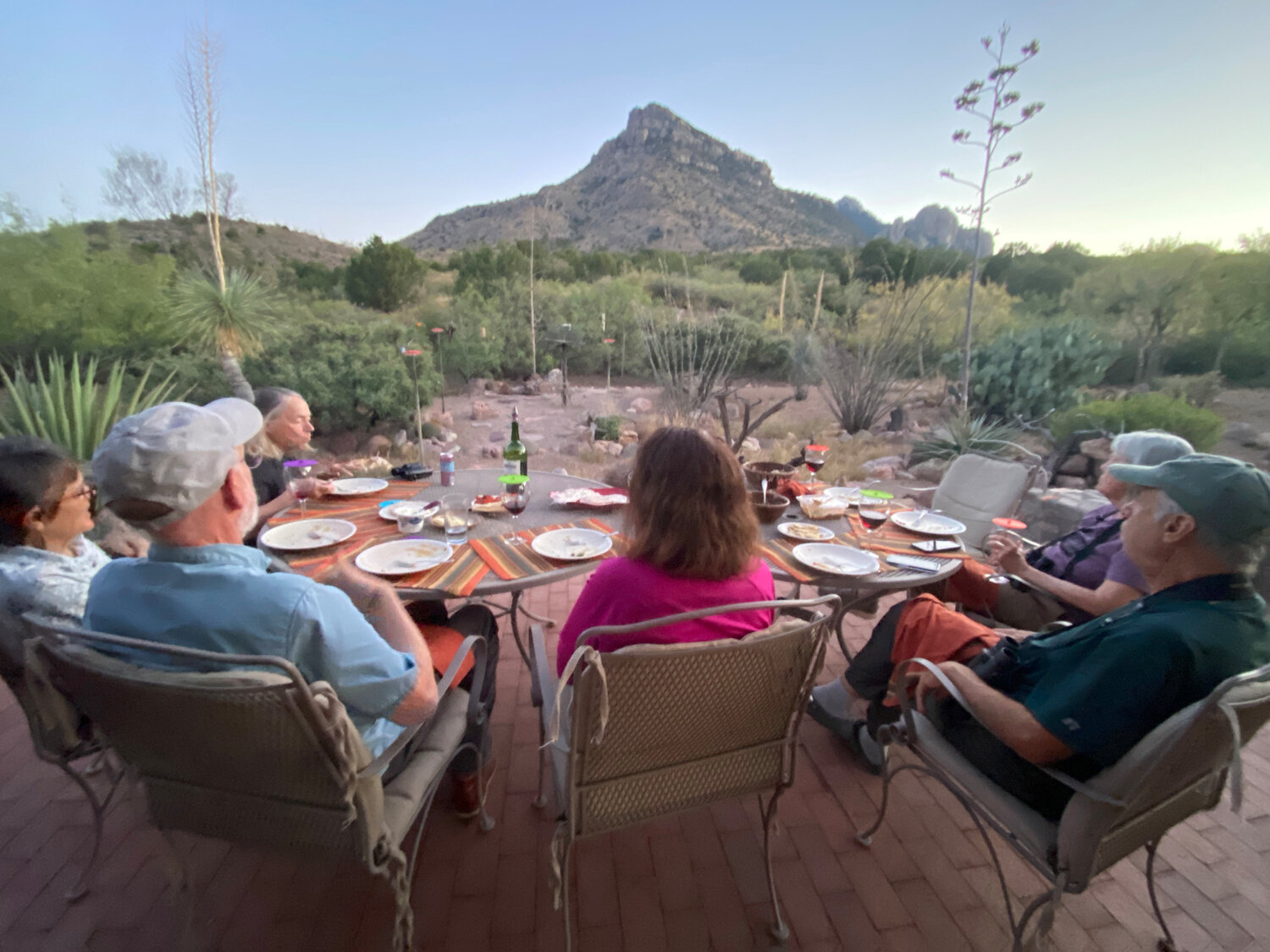
By Pat Foster-Turley
I can’t recall any evening show I watched with friends that was better than this. Three longtime gal friends of mine, now scattered around the country, met with me for a week of nature and togetherness in southern Arizona. And one of these biologist friends had her own friends living in Portal, Arizona who graciously invited us to drinks and snacks at their home bordering the Coronado National Forest — an open wilderness that stretches for miles from their backyard.
So, at 5 p.m., we showed up at their home for their evening show. Our hosts had set up chairs in a semicircle, with a table loaded with edibles in front of us and their natural backyard with the wilderness beyond. Like most people we met in Portal, our friends had designed their yard to attract wildlife for viewing, with water features, bird feeders and native plants. We no sooner got settled in our chairs when the show began.
My friends are primarily birders, very attuned to the rich diversity of birds in this hotspot in the Chiricahua Mountains, with binoculars always at the ready to identify even the tiniest brown-colored bird that I could barely see with my naked eyes. But no matter. What I could see surpassed my wildest expectations.
While they were intently focused on the hummingbirds that came and went at their feeders — nine different species of hummingbirds visit here — I had plenty to look at myself. Take the javelinas, for instance. These pig-like animals called collared peccaries elsewhere, are a regular feature in this area. I contentedly watched a group of them visiting the watering hole provided for them right in front of us. The group of adults with one small baby spent long minutes at this spot, in easy viewing without binoculars. Some people in Arizona view these animals as giant pests that destroy their gardens, and threaten them if they approach too closely to a mother with babies. But our Portal friends had no problem encouraging their visits to their waterhole. Their yard was intentionally maintained with native plants that javelinas don’t bother and lots of rocks and sand in between.
While the javelinas were busy at the waterhole, other animals appeared too. A brush rabbit hopped into view and a group of Gambel’s quail patrolled the yard. Between these sightings, I looked at the many birds visible even to my naked eyes, listened to my friend’s commentary about them, and scanned the desert environment closely for lizards and snakes, which are also abundant here. My friends, on the other hand, were captivated by the sighting of a rare-in-these-parts Lucifer hummingbird. We were all happy.
As we sipped wine and ate appetizers, darkness approached, and the second act of the show began. Bats! Here on Amelia Island, Florida the bats we see (if we see any these days) are insect eaters, like most bats in the United States. But not these bats. Our host took down the hummingbird feeder under the eaves and put up a fresh one with new nectar. And, in came the bats, nectar-feeding bats, who would imagine this! Three species of nectar-feeding bats migrate from Mexico to Arizona and back again, feeding mostly on flowering agave and tubular cactus flowers, but also visit hummingbird feeders at night. These bats were undeterred by our yakking presence and the lights we shone on them. One by one, they quickly swooped in to suck up a mouthful. What fun!
Video: Nectar-feeding bats visit the hummingbird feeders at night.
To view this video please enable JavaScript, and consider upgrading to a web browser that supports HTML5 video
It was getting late, and time to drive down the gravel roads back to Cave Creek Ranch. But not before gazing up for the third act of this nature show. It was a near moonless dark sky night in the Dark Sky Chiricahua area. And wow, the stars! For the first time in years I got a great view of the Milky Way and an appreciation for all the stars in the sky that are normally overshadowed by the light from houses, cities, and the like. Even with lights turned off for sea turtles, our Amelia Island beaches bordering the vast Atlantic Ocean always have light obscuring the stars. But not here. It turns out that Portal, Arizona, has attracted not only biologists like our hosts who enjoy the wildlife — it has also attracted astronomers from all over who have moved here with their high-powered telescopes and settled in what locals call the Sky Village.
Of course, living so close to nature in southern Arizona has its exciting side too. The day we left Portal our hosts posted a photo of a large diamondback rattlesnake that they found in their yard, coiled up and not disturbed by their weed-whacker right over its head. Our host carefully put the snake in a garbage can out of the way until he finished his yardwork, then released it right where he found it.
And that’s a biologist for you! My kind of people!
Pat Foster-Turley, Ph.D., is a zoologist on Amelia Island. She welcomes your nature questions and observations. [email protected]
